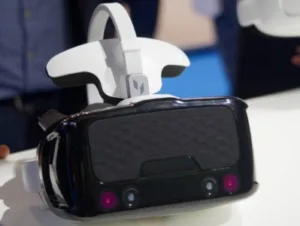JVC had nothing new in the projection area since its product launches at I/Itsec although it had blended displays on show that were supported by IGs from Thales, a partner company. The company told us that the low black level that it is able to achieve from its D-ILA technology is a critical factor in its market penetration in simulation and many of its clients insist on good performance in night modes. Clients for its projectors include Boeing, Flight Safety and Rockwell Collins.
JVC did have a couple of prototype VR headsets, both using a single display panel, one with 2560 x 1440 resolution and the other with 3840 x 2160 and featuring a 120º field of view. The centre performance of both headsets was good with screen door effects not too bad on the UltraHD model.
However, an unusual feature was the integration of dual sensors for hand detection, based on technology from Leap Motion. We tried a demonstration and found the tracking of the hands and fingers to be very good. (In a demonstration of the HTC Vive Pro, using Leap Motion, that we tried at CES, we were impressed with how much more immersive a fork lift truck driving simulation was, when we could see our hands in the display, although that demo also highlighted some mis-registration between the physical controls and the image.).
 This prototype headset from JVC has hand tracking from Leap Motion – it was good. Image:Meko
This prototype headset from JVC has hand tracking from Leap Motion – it was good. Image:Meko
 JVC also showed this prototype headset, without hand tracking. Image:Meko
JVC also showed this prototype headset, without hand tracking. Image:Meko

